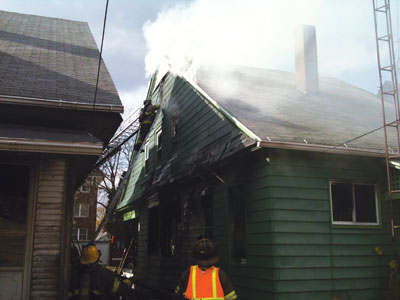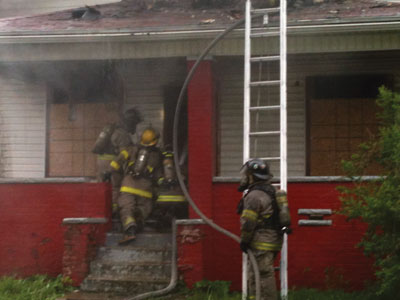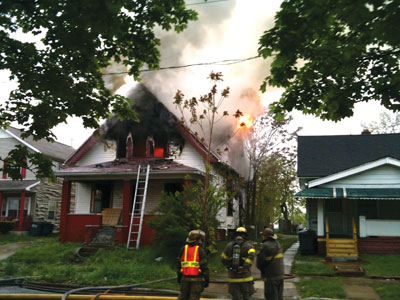
Features
Structural
Training
Fire attack – part 3
When we left each other in April, we were fighting a fire in a two-storey, wood-frame, single-family dwelling, with heavy, fast-moving smoke conditions coming from the upstairs windows on side alpha.
July 6, 2012
By Robert C. Krause
When we left each other in April, we were fighting a fire in a two-storey, wood-frame, single-family dwelling, with heavy, fast-moving smoke conditions coming from the upstairs windows on side alpha.
 |
|
| Using the oriented-man search technique in residential structure fires allows firefighters to maintain communication while doing a primary search. Photos by Robert Krause |
Family members outside of the burning structure reported to the first-arriving engine, staffed with three firefighters, that their teenage son is unaccounted for and may still be in the house.
Armed with this information, the incident commander gave an order for an initial attack line to be pulled to the second floor to attack the main body of fire. The reasoning behind attacking the fire first, instead of directly searching for the missing teenager, is that if the fire is allowed to go unchecked, and a firefighter begins search operations in a house that is actively burning, the risk to the searching firefighter and the potentially trapped victim is enormous.
A fire that is not controlled will continue to develop in intensity, heat production, and toxic smoke, and can result in firefighters being trapped in the burning structure. Limited staffing on first-arriving fire crews will determine what tasks can be completed quickly, efficiently and safely.
This scenario calls for attacking the fire first, which will begin to immediately improve interior conditions, making search efforts more effective and improving conditions within the structure for both firefighters and potential victims.
Once additional firefighters begin arriving on scene, the incident commander orders a crew to begin search efforts; a technique called the oriented-man search is a quick and effective way to look for potential victims.
Search efforts should begin close to the fire area. Beginning search operations closest to the fire area allows for victims trapped near the fire to be rescued early, increasing their chance for survival.
Additionally, searching areas of the house not involved in fire can waste precious time locating trapped victims who may be near the fire area.
The oriented-man search technique can be used with two or more of firefighters. As the search team moves to the second floor, the company officer or firefighter in charge of the search team should be considered the oriented man.
 |
|
 |
|
| The oriented man should be the last person out of the search area after there has been a full accounting of all firefighters in the search team. Photos by Robert Krause
|
The oriented man maintains a position near the stairwell or in the hallway of the second floor. The remaining firefighters will individually enter bedrooms searching for potential victims. The oriented man will maintain verbal contact with the searching firefighters; this verbal contact provides searching firefighters with a point of reference – a point of orientation – so the searching firefighters are able to find their way back to the hallway once they complete a search of the bedroom.
It is very important for the oriented man to maintain verbal contact with the searching firefighters, observe fire and smoke conditions within the search area, and continuously provide a point of orientation for the search team.
Keep in mind that most residential bedrooms are 10 feet by 10 feet or 12 feet by 12 feet and can easily be searched by one firefighter. Certainly, larger bedrooms can be found in some homes, which may require additional firefighters to search. Once the area nearest the fire has been searched for potential victims, the search team should move to other areas of the structure to search for potential victims. The oriented man should be the last person out of the search area after there has been a full accounting of all firefighters in the search team.
If a victim is located, the next decision to be made is the best route for removal. Can the victim be carried out the same way the search team came into the structure? Can the victim be carried by the firefighters from the search team or are additional firefighters needed? Can the firefighters remove the victim through the bedroom window onto a ladder from the second floor? Do the searching firefighters who located the victim have enough air remaining in their breathing apparatus to remove the victim from the fire building? Should additional firefighters with full air cylinders on their breathing apparatus be sent in to remove the victim? These are questions that should be discussed around the kitchen table at your fire halls. Pre-planning your search and rescue operations will make you more efficient and safer on the fire ground. Regular practice and training of victim removal using a variety of methods is your best chance to successfully rescue a trapped victim under live fire conditions.
Regular practice of the oriented-man search technique will speed your search operations when called upon at 2 a.m.
In the fire scenario presented above, the search team using the oriented-man search technique located the missing teenage boy in his second-floor bedroom. Upon finding the boy, the search team decides the best method for removing the boy is via the bedroom window onto a ladder outside the building. The search team leader notifies the incident commander that the young man has been found, and that the search team needs a ladder placed to the second-floor bedroom to remove the victim. The bedroom door should be closed and then the window should be taken out; all glass including the sash should be removed from the window opening, as this will create an area large enough to remove the child and allow for the firefighters to easily exit onto the ladder. Closing the bedroom door prior to opening the window prevents the induction of fresh air into the fire building and greatly reduces the chance for fire spread as a result of the window being opened. Once the window is taken out and the ladder is placed below the window sill, a firefighter can climb out on to the ladder to prepare to have the victim handed to him and begin the descent down the ladder. As soon as the incident commander is made aware that victim has been located, he should notify EMS so that paramedics can prepare to deliver patient care.
The fire-attack team located the main body of the fire in a bedroom at the opposite end of the hallway from where the teenage boy was found. Using a straight or solid stream, and flowing at least 150 gallons per minute (GPM), the fire was quickly knocked down with a single line. The incident commander should direct crews to check the attic for fire extension. Fire can quickly travel into the attic area and, if left unchecked, can grow quickly and create a large volume of fire in the attic space. In this particular fire, there was no extension into the attic space and the fire was contained within the bedroom.
Ventilation can be completed using a positive-pressure fan placed in the front door of the structure, with the window in the bedroom that was on fire opened or broken out. Closing other bedroom doors allows for the positive-pressure fan to have the greatest effect in removing smoke and toxic gases through the open window in the burned-out bedroom. Fire did not extend to any other regions of the home and the incident commander declared the fire under control.
Further investigation revealed an unattended candle left in the bedroom was most likely to have caused the fire. The family attributes its survival to the working smoke alarms that were placed throughout the house. Swift and decisive action by the incident commander and the well-performed activities by both the fire attack and search crews resulted in the missing boy being located and successfully rescued from the fire building.
Successful fire scenarios such as this one are repeated regularly throughout North America, and are result of the dedication, commitment, training and practice of the men and women in our neighbourhood fire halls. Keep up the good work.
Lastly, I would like to close with a brief discussion on the use of two-and-a-half-inch lines for fire attack. When presented with a large volume of fire in a residential structure, and especially a commercial structure, I encourage first-arriving crews to deploy a two-and-a-half-inch line with a one-and-one-eighth-inch tip that will flow 265 GPM or a one-and-a-quarter-inch tip that will flow 328 GPM. The superior knockdown capability of these larger lines cannot be understated. Two firefighters can advance a two-and-a-half-inch line with the nozzle configurations listed above, but it takes practice.
Certainly some of you that will say it is too hard or it’s too heavy and to that I respond, firefighting is hard work, you want something easy, go somewhere else. Heavy fire conditions must be met with large volumes of water, the two-and-half-inch attack line is the weapon of choice when fighting large volumes of fire, especially in commercial dwellings where the fire load is considerably larger than that of a residential structure.
Don’t worry about water damage; water damage is caused by an untrained crew that doesn’t know when to shut down the nozzle.
I encourage each of you to practise pulling, stretching and flowing water through your two-and-a-half-inch attack lines. Try using the smoothbore nozzle tip size as I suggested as well as any combination nozzles that you may have. Keep in mind that, when using a combination nozzle on a two-and-a-half-inch line, the nozzle reaction (push back) will be significantly higher compared to a smoothbore nozzle. Specifically, a combination nozzle set at 250 gallons per minute will have a nozzle reaction of 125 pounds. (Whatever the GPM setting is on a combination nozzle, one half of that number will be nozzle reaction, so 150 GPM = 75 pound nozzle reaction and so on.)
I hope you found these articles useful and will consider adopting some of the ideas into your firefighting operations. I look forward to talking with you again in the near future. Until I do, train hard and stay safe.
Bob Krause is a battalion chief with the City of Toledo fire department in Ohio and is assigned to Battalion 2. He has 32 years’ experience in emergency services. He holds an International Fire Service Accreditation Congress (IFSAC) certification and several other EMS and fire certifications. Krause has held a variety of positions in the fire service including engine company officer, fire training officer, Fire & EMS Academy program director, fire/EMS communications supervisor and chief of emergency medical services. He is working to complete his doctorate in emergency management. E-mail him at rcktfd@bex.net.
Print this page